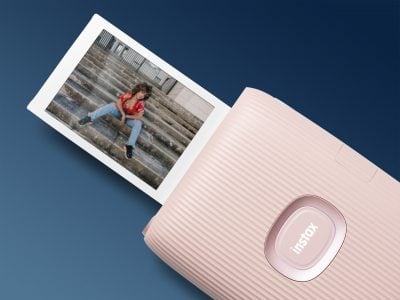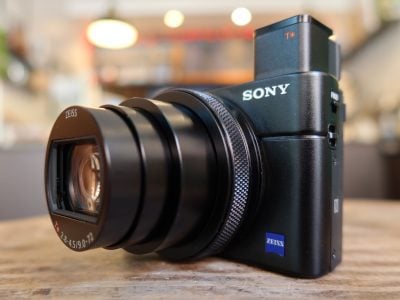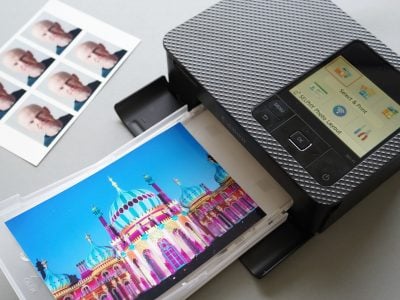Olympus Zuiko Digital 25mm 1:2.8 ‘pancake’
-
-
Written by Gordon Laing
Verdict
The Olympus Zuiko Digital 25mm ‘pancake’ lens is an ideal general-purpose lens for any Four Thirds owners who value portability. It is first and foremost really very small, measuring 64mm in diameter and just 23.5mm thick. This makes it considerably slimmer than any other Olympus lens, and is almost one third the length of the already compact 14-42mm kit lens. It’s also very light at 95g, or half the weight of the 14-42mm.
Fit the 25mm pancake onto one of the Olympus E-4xx series bodies and you’ll have yourself a seriously small DSLR kit that won’t place a burden on any bag, and that will actually squeeze into larger coat pockets. Indeed while the combination remains bigger than enthusiast compacts like the Canon PowerShot G9 or Sigma DP1, it’s sufficiently manageable for many to consider it as their ‘pocketable’ go-anywhere camera. The E-5xx series are obviously bigger, but they’ll also benefit from the 25mm pancake’s compact dimensions, transforming them into smaller, more portable kits.
The 50mm equivalent focal length is also ideal for general-purpose use – after all, this was the focal length 35mm film SLR owners relied on for years. If you’re used to zooms, there’s understandably some concern of reduced flexibility, but in practice the 50mm equivalent coverage is more usable than you’d think.
As you’ll see in our Gallery section, you can still squeeze in a reasonable landscape shot, while also being able to take a decent portrait with a small depth of field. Indeed in the absence of a zoom, you’ll find yourself adjusting angle and position more often, exploring the shot with arguably better results than simply standing still and zooming in and out. It’s a refreshing change if you only know zooms, and for anyone who used 50mm lenses on 35mm film SLRs, a welcome reminder of the old days.
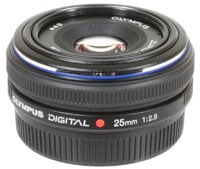
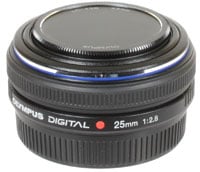 |
Optically it’s brighter than most kit zooms too. Models like the popular Olympus 14-22mm start at f3.5 when zoomed-out and end at f5.6 when zoomed-in. This means the 25mm pancake is two thirds of a stop brighter than the kit zoom at wide angle, and two stops brighter when it’s zoomed-in. This brighter aperture gives it an advantage in low light situations, while also allowing a smaller depth-of-field to be achieved – handy for portrait work.
It’s not all good news though. While the 25mm pancake delivers sharp results across the frame, there’s some coloured fringing in the corners even with the aperture closed-down. It’s also unremarkable as a macro lens and there’s measurable barrel distortion, albeit roughly the same as the 14-42mm at the same focal length.
The focusing speed is by no means the quickest around, nor the quietest either. And physically speaking, the screw-on lens cap may be tough, but it’s slower to remove and refit than a clip-on model. Price-wise, it’s also more expensive than the 14-42mm zoom when bought in a kit, and it’s a shame it wasn’t possible to achieve a brighter aperture. Canon’s EF 35mm for instance costs roughly the same, delivers similar coverage when mounted on a cropped body and boasts an extra stop at f2.0, although it weighs over twice as much and is almost twice the length.
Ultimately it really boils down to how much you value the portability aspect and whether you can live with a fixed focal length lens. In terms of the latter, if you are going to have a fixed lens, then one with a 50mm equivalent coverage will arguably be most useful for day-to-day use.
The portability question is tougher, especially as the current 14-42mm kit lens is already pretty light and compact, and many will find it more than acceptable as a small and light general-purpose option.
If you’re not bothered about size and weight and are happy to pay more for something brighter, then there’s other standard coverage options worth considering. How about the Sigma 24mm f1.8 which is over twice as bright for about 50% more money, albeit five times heavier and over three times longer. Or the Sigma 30mm f1.4 which is four times brighter and boasts quick and quiet HSM focusing for about 75% more, although again is bigger, and much heavier. Or perhaps the Leica 25mm f1.4, again four times brighter, but again five times heavier, three times longer and costing considerably more.
But if you really value portability and having something half the weight and almost one-third the length of the 14-42mm kit lens, while still being optically brighter, then the 25mm pancake is well worth considering. It will literally transform an E-4xx series camera into the most pocketable working DSLR to date. Owners of the E-4xx series already appreciate portability and for them, the 25mm pancake is the closest thing to a no-brainer.
Owners of the E-5xx series will also benefit from the smaller size and weight of the lens, although the combination won’t be as compact as an E-4xx. That said, it’s still a great option if you’re after a standard lens or want to reduce the size and weight of your DSLR kit. Owners of the E-3 may find the standard focal length useful, but any physical benefits of the lens are literally far outweighed by the flagship body. They’re more likely to consider something brighter like one of the Sigma models.
Ultimately most DSLR owners consider a standard focal length lens at some point for their collection, and for Four Thirds owners, that means something with a focal length of around 25mm. The pancake hits that particular nail on the head while additionally boasting very slim dimensions and light weight. As a standard lens alone we can recommend it, but if you have one of the smaller Olympus bodies and value portability, then it’s an unbeatable choice. Indeed we’d say it’s mandatory if you bought an E-4xx for its compact dimensions.
Good points Very slim and light. Ideal for smaller bodies. Coverage suitable for general-purpose use. Bright f2.8 aperture. Usable manual focusing ring.Bad points Lacking the focal range flexibility of a zoom. Coloured fringing in corners. Screw-on lens cap slow to fit and remove. 14-42mm is cheaper when bought in a kit. | Scores (relative to other Olympus lenses) |  | |||
Build quality: Optical quality: Specification: Value: Overall:
| 18 / 25 20 / 25 18 / 25 20 / 25 76% | ||||
